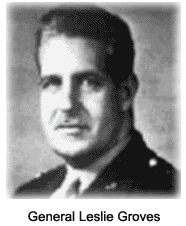General Leslie R. Groves was the man in charge of the Manhattan Engineer District, best known as the Manhattan Project, through which the United States developed the first atomic bomb. He spent two billion dollars and employed as many as 125,000 people in a project operating in total secrecy.
 Leslie Richard Groves was born in Albany, New York, on August 17, 1896. He spent a year at the University of Washington and two more at MIT before entering West Point, from which he graduated in 1918. He received a commission in the Engineers and spent the time between world wars in a variety of assignments in the United States and around the world. Assigned to the Office of the Chief of Engineers in Washington D.C. in 1940, his responsibilities included oversight of the construction of the Pentagon. By the summer of 1942, Groves was basically supervising all army construction in the United States.
The Manhattan Project was launched in August, 1942 and Groves was put in charge the following month. In under three years, Groves led the project through basic research, bomb design, production of fissile material, testing and deployment of the world`s first atomic bomb. Remarkably, during this entire period, no major breaches of security took place.
Groves was given extraordinary power to achieve his objectives. As one of his assistants put it after the war, "General Groves planned the project, ran his own construction, his own science, his own army, his own State Department and his own Treasury Department."
The decision to drop the atomic bomb has been much debated. Groves` role is usually not emphasized, but in fact it was his operational timetable that made two bombs available in early August, 1945. Only an extraordinary challenge to the momentum surrounding the bombs would have prevented their use, and none was forthcoming.
Many of Groves` policies, such as running large projects through corporate contractors and shielding decisions from outside scrutiny, were continued at the successor organization to Manhattan Engineer District, the Atomic Energy Commission. Groves himself, however, did not adapt well to peacetime. The high-handed methods which had kept the mammoth project on a tight schedule were not appropriate afterwards and Groves found himself with powerful enemies. His early retirement took place in 1948, after which he served as a Vice-President for Remington Rand, later Sperry Rand. He retired from Sperry in 1961. His book, "Now It Can Be Told," appeared in 1962. He died in 1970.
Leslie Richard Groves was born in Albany, New York, on August 17, 1896. He spent a year at the University of Washington and two more at MIT before entering West Point, from which he graduated in 1918. He received a commission in the Engineers and spent the time between world wars in a variety of assignments in the United States and around the world. Assigned to the Office of the Chief of Engineers in Washington D.C. in 1940, his responsibilities included oversight of the construction of the Pentagon. By the summer of 1942, Groves was basically supervising all army construction in the United States.
The Manhattan Project was launched in August, 1942 and Groves was put in charge the following month. In under three years, Groves led the project through basic research, bomb design, production of fissile material, testing and deployment of the world`s first atomic bomb. Remarkably, during this entire period, no major breaches of security took place.
Groves was given extraordinary power to achieve his objectives. As one of his assistants put it after the war, "General Groves planned the project, ran his own construction, his own science, his own army, his own State Department and his own Treasury Department."
The decision to drop the atomic bomb has been much debated. Groves` role is usually not emphasized, but in fact it was his operational timetable that made two bombs available in early August, 1945. Only an extraordinary challenge to the momentum surrounding the bombs would have prevented their use, and none was forthcoming.
Many of Groves` policies, such as running large projects through corporate contractors and shielding decisions from outside scrutiny, were continued at the successor organization to Manhattan Engineer District, the Atomic Energy Commission. Groves himself, however, did not adapt well to peacetime. The high-handed methods which had kept the mammoth project on a tight schedule were not appropriate afterwards and Groves found himself with powerful enemies. His early retirement took place in 1948, after which he served as a Vice-President for Remington Rand, later Sperry Rand. He retired from Sperry in 1961. His book, "Now It Can Be Told," appeared in 1962. He died in 1970.